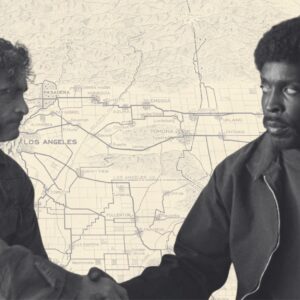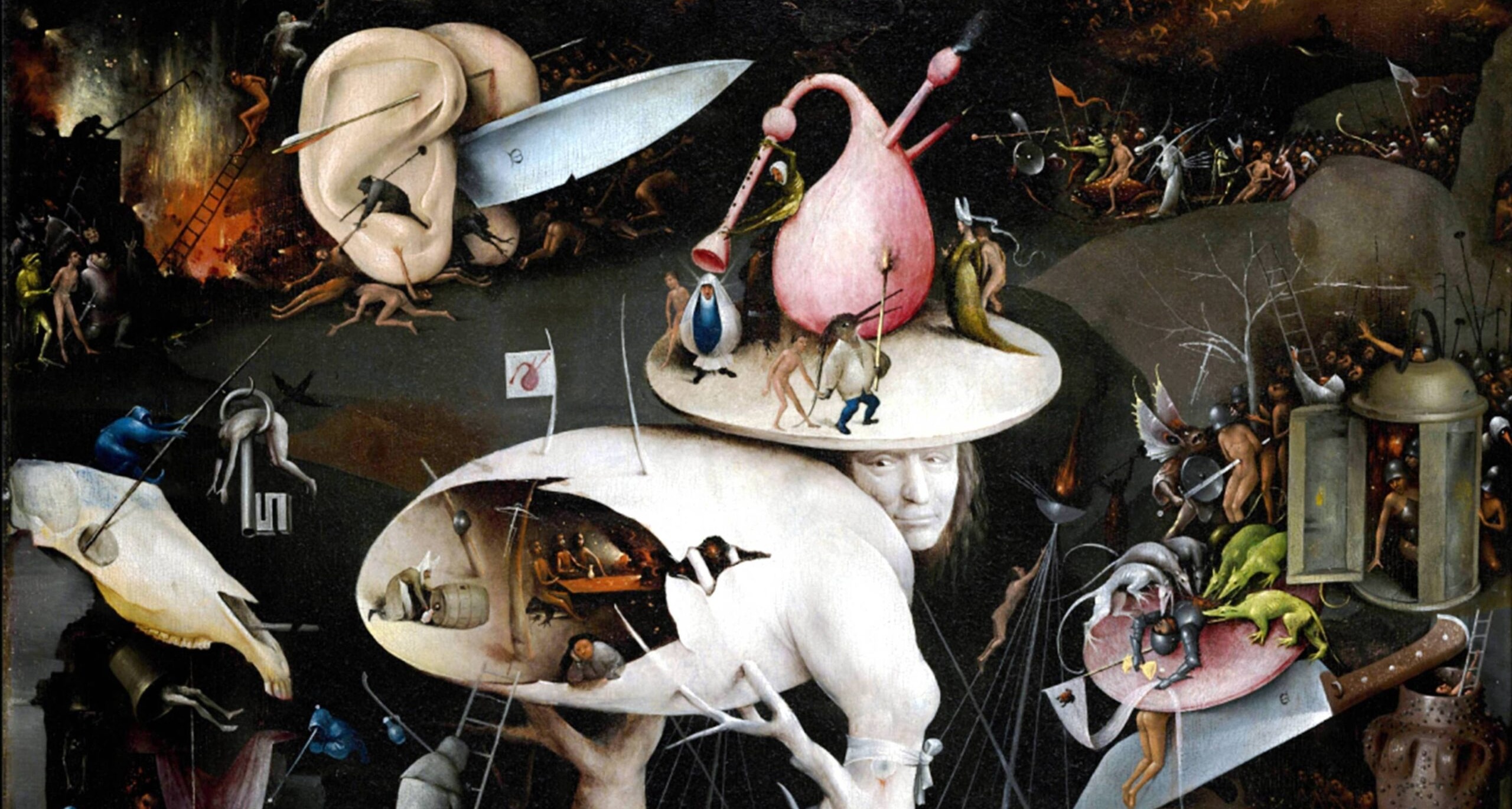
Corporeal Punishment: On Body Horror, That Most Human of Stories
Tyler Malone Explores the Uncanny Valley Between the Body and the Self
I. Vestigial Tale As Old As Time
I intend to speak of bodies changed to new forms. I intend to speak of transformation, of metamorphosis, of mutation. I intend to speak of the self othered from itself. I intend to speak, therefore, of body horror.
The term “body horror” was coined by Philip Brophy in a piece called “Horrality: The Textuality of the Contemporary Horror Film,” published in a 1983 issue of the Australian magazine Art & Text. In the article, Brophy cataloged a number of what were then recent trends in the horror genre: “Perhaps what has been an even more prolific trend is the destruction of the Body. The contemporary Horror film tends to play not so much on the broad fear of Death, but more precisely on the fear of one’s own body, of how one controls and relates to it.”
The term that would eventually become the name of a subgenre came about in Brophy’s detailed dissection of The Thing (1982), which he claimed “took to its logical limit the Body-horror that was initiated in Alien (1979).” Though he highlighted films by John Carpenter, Ridley Scott, Brian de Palma, and John Landis, Brophy gave a special distinction to David Cronenberg, who he noticed, even in that early phase of his career, had “consolidated himself as a director who almost exclusively works in this field.” Mind you, this was written before Brophy had seen Cronenberg’s Videodrome (which, though released in early 1983, wouldn’t make it to Australia until the following year) and before Cronenberg had made The Fly (1986), Crash (1996), and eXistenZ (1999).
“It all begins with the body,” Cronenberg once said. “The first fact of human existence is the human body.” In his view, “the human body is the reason the cinema was invented. The face, the body, is its true subject, the most photographed object in cinema. Cinema is the body.”
But in having “made a career out of bodies,” to borrow a phrase from Cronenberg’s most recent film The Shrouds (2024), the director created a need for a term that would define this supposedly contemporary inclination. Brophy—who would himself go on to direct the body horror cult classic Body Melt—merely fulfilled that need.
But body horror didn’t begin with Cronenberg—nor did it begin with cinema. Body horror has likely been around for as long as humans have had bodies and could tell stories about them. Our oldest surviving tales—the myths of ancient cultures—prove this as an early strain of horror.
The legends of these primitive peoples often emerged through attempts to explain the strange physical world they found themselves in and its terrifying occultation. Why does the sun set in the west each evening? Where does it go? What in the dark nothingness of night swallows the moon bit by bit until it disappears altogether? What makes the clouds sometimes leak? Why have so many of our crops died this year? Why did that mountain cast a deathly black cloud across the land? All incredibly important questions for a species stumbling in the dark, and it was in this cloud of unknowing that man with outstretched hands sought truth and invented story.
The body has remained central to horror through the ages.
But perhaps the thing that needed the most explanation wasn’t actually a mystery of the outside world at all, but one more terrifyingly at hand: the body moving through space and time. Early humans must have been extremely puzzled—as we still are to some degree, even with all our advances in science and technology—by the constant changes, vicissitudes, and variabilities of the human body.
This is why one of the most common tropes in ancient narratives is transformation. The topic was so prevalent in the myths of Ancient Greece that “metamorphosis poetry” became a Hellenistic tradition. One of the earliest examples of this is the Ornithogonia of Boios, a long-lost collection of tales, each of which involved a figure’s transformation into a bird. By the time the Roman poet Ovid wrote his classic Metamorphoses in 8 CE,—which starts, as I have here, with the phrase “I intend to speak of bodies changed to new forms”—the literature of transformation was already centuries old.
Therianthropy—the shapeshifting of humans into other animals—was undoubtedly the most common form of body horror in the stories of the old world. Lycanthropy—or “werewolfery” as it’s called in Werewolf of London (1935)—is likely the most culturally persistent version of therianthropy in Western horror stories. It’s also one of the oldest: The Epic of Gilgamesh (c. 2100 BCE) includes a story of Ishtar turning a former lover into a wolf. In another early example, the myth of King Lycaon—the Greek figure from whose name the root of the word “lycanthropy” comes—the king kills and cooks his son Nyctimus and serves him to Zeus to test if the god will recognize human flesh; for this awful deed, Zeus forces Lycaon to live the rest of his days as a wolf.
But the transformation of humans into other animals was far from the only way the instability and incomprehensibility of the body showed up in ancient narratives. Staying with just the myths of Ancient Greece, we find the confusion of gender (see: Tiresias, Caeneus, Iphis, Hermaphroditus); the complications of disability (see: again Tiresias—blind, the club-foot of Hephaestus); the horrific mutilation of the flesh (see: Prometheus bound and bedeviled by a liver-hungry eagle, the Dionysian rite of sparagmos, Procrustes and his iron bed, the various eternal tortures of Tartarus); the fusion of bodies with technology (see: the shoulder of Pelops, the wings of Icarus, the wooden cow Daedalus made for Pasiphaë so she could enact her bestial desires); and the terror of disease, deterioration, death, and decay (see: the Nosoi, the concept of miasma, the necromancy of Thessalian witches).
The body has remained central to horror through the ages: we gaze upon it in Hieronymus Bosch’s The Garden of Earthly Delights (c. 1500, pictured above), Théodore Géricault’s Severed Heads (1818, pictured below), and Salvador Dalí’s Autumnal Cannibalism (1936); we read about it in Mary Shelley’s Frankenstein (1818), Bram Stoker’s Dracula (1897), and Franz Kafka’s The Metamorphosis (1915); and, as cinema emerged as a popular artform, we found it there too.
“Cinema is the body,” after all. So sayeth David Cronenberg.
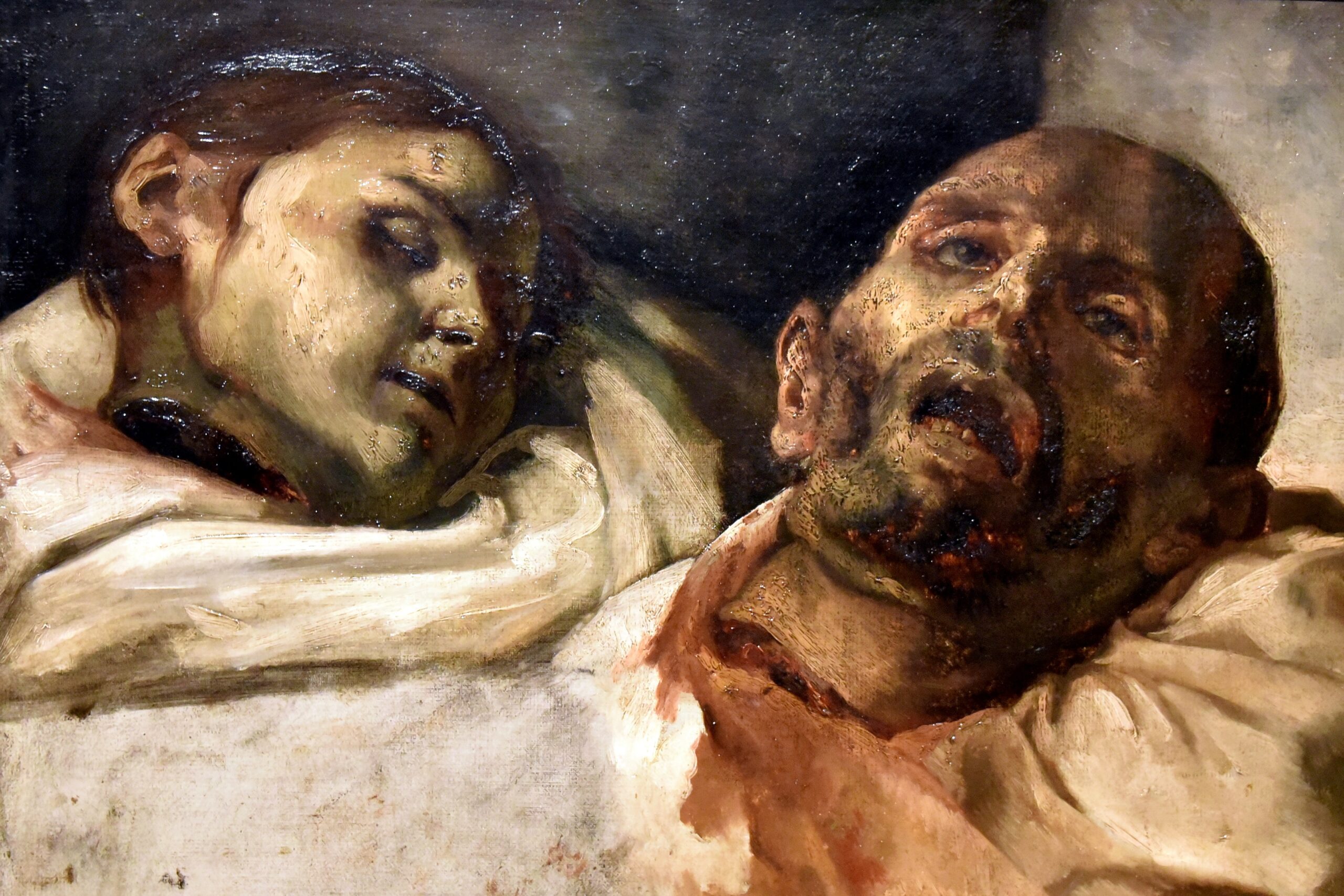
II. The Treachery of Cinema
René Magritte’s famous painting The Treachery of Images (1929) depicts a pipe under which is written in French, “This is not a pipe,” yet when we look at the painting, we see the pipe, even against instruction. We know it’s merely black and brown paint on a canvas, but we recognize a pipe. This is the treachery of images: they can convince us of a reality that is not real.
Cinema, which involves more than the single image of a painting, is a series of images flickering by at 24 frames-per-second that creates the illusion of movement. Corresponding sound only adds to the illusion. Film is obviously a more immersive experience than a painting could ever hope to be. Its images, therefore, become even more treacherous.
Theorist Julia Kristeva, in her book Powers of Horror, explains that the abject “is radically excluded and draws me toward the place where meaning collapses.” Abjection, therefore, is a separation from and piercing through the norms and rules of the Symbolic Order:
It is thus not lack of cleanliness or health that causes abjection but what disturbs identity, system, order. What does not respect borders, positions, rules. The in-between, the ambiguous, the composite.
In other words, the abject gives us a brief, mystifying glimpse of the occulted world—that always-already-terror that precedes all understanding and escapes all symbolization.
What changed in the second half of the 20th century that necessitated the invention of the term “body horror” was the dissolution of the Hays Code.
Being confronted with a corpse is perhaps the best example of the abject. Kristeva explains that the corpse, the most sickening of wastes, is a border that has encroached upon everything. It is no longer I who expel, “I” is expelled. The border has become an object. How can I be without border? That elsewhere that I imagine beyond the present, or that I hallucinate so that I might, in a present time, speak to you, conceive of you—it is now here, jetted, abjected, into “my” world.
The void that our symbolization avoids is in the cadaver—is cadaver (from the Latin cadere: “to fall”).
Before the body horror explosion in the ‘70s and ‘80s, Alfred Hitchcock hinted at this in Psycho (1960), when Lila Crane extends her hand to the shoulder of Norman Bates’s mother, and as the mother’s corpse turns its course in its swivel chair, we see, as she sees, the mummified face of the mother’s skeleton, its abyssal eyesockets. Lila’s flailing hand knocks the hanging light in the fruit cellar, and shadows dance in the place where the mother’s eyes should be, the empty window frames to the absence of the soul.
Hitchcock’s later film, The Birds (1963), contains an echo of this approximate abjection, but the repetition is perversely distorted, as echoes often are. When Lydia Brenner visits her neighbor, she finds his corpse in the bedroom, eyes pecked out by birds. To exacerbate the abjection this time, Hitchcock makes it more cinematically confrontational with three shots which take us increasingly closer to the gaping holes in the head through silent staccato zoom cuts.
What changed in the second half of the 20th century that necessitated the invention of the term “body horror” was the dissolution of the Hays Code and the evolution of practical effects, allowing filmmakers to more accurately—and more grotesquely—approximate the abject.
Brophy, in that 1983 essay, pointed out in his piece this major difference between horror films that dealt with the body in the past and the body horror of more contemporary cinema. One of Brophy’s examples: An American Werewolf in London (1981) shows the audience in gruesome detail “the transition from Man to Werewolf in real time, as opposed to the ellipse-time of the dissolves of Lon Chaney Jr.’s face” in The Wolf Man (1941), four decades prior.
During Tina Gray’s dream of Freddy Krueger chasing her down an alley in A Nightmare on Elm Street (1984), there’s a moment where Krueger stops for a moment of theatricality, saying, “Tina, watch this.” He proceeds to chop off two of his fingers with his own razor glove; the wounds squirt green goo [pictured below]. When he finally pounces on her, she reaches her hand up to his face; the skin slides right off, revealing a bloody mess of meat and bone beneath.
Scenes like this may not actually succeed at freeing themselves from the Symbolic Order since movies are by nature language, narrative, meaning, yet the treachery of cinema allows these scenes to approximate the abject, convincing us of an imposition of the Real that is not real.
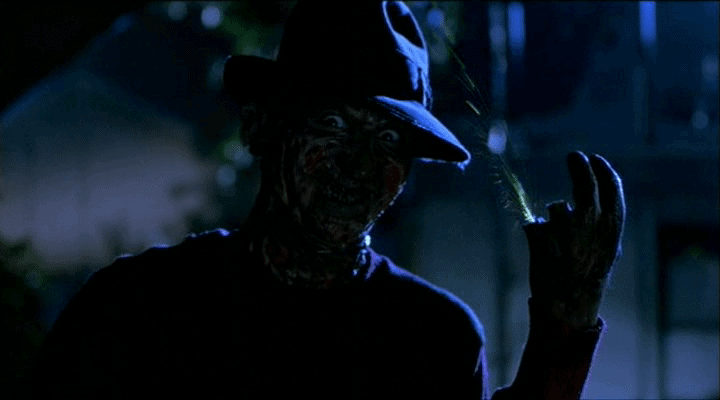
III. Not Your Body, Not Your Choice
My body is a temple—or so I’m told. The effectiveness of body horror as a tool for instilling fear and discomfort and approximating abjection depends upon this conviction. We do not like to witness the desecration of this temple because it is sacred to us. Indeed, we believe it is us. We identify with our bodies. But should we?
The metaphor of the body as a temple is not actually the egregious fiction in the phrase “My body is a temple.” The first two words—“my body”—pose a knottier problem.
In a Guardian interview for her debut film Raw (2016), French Cronenberg-acolyte Julia Ducournau explained, “I was aware that my body could mutate in unexpected ways and have autonomy. You haven’t decided to have a rash, it’s your body doing it. So, are you your body or is your body you? This is the kind of thing I always thought about: what does it mean in terms of identity?”
The initial terror of body horror is our revulsion in witnessing the deformation or destruction of the one thing that is decidedly ours—our body—but the body horror film, like Brophy’s description of the Thing in The Thing, “does not honor any of our beliefs or perceptions of what the human body is.” This disturbing truth is the subsequent terror in witnessing the body’s deformation or destruction, one that is infinitely more repulsive: that the one thing we think of as our own has never really been ours to own.
So, if the body is a temple, whose temple is it? Which deity is worshipped in its pews? What gospel is preached from its pulpit? Who is giving the sermon and to whom? We like to think that we determine the temple’s denomination ourselves, but this convenient desire betrays a misplaced faith in our bodily autonomy.
You are the thinking of thoughts; you are the thinking thoughts. You are your consciousness, not your body. The body is other. It’s the skin you live in.
“My body, my choice” read the signs at marches for women’s reproductive rights. (The slogan has since been cynically co-opted by anti-vaxxers and can often be found wherever they congregate too.) As a political entitlement, bodily autonomy is certainly important to the social fabric of any civilization attempting some semblance of freedom and justice. “Not only is bodily autonomy a human right,” according to the United Nations Population Fund, “it is the foundation upon which other human rights are built.”
Bodily autonomy is, indeed, a lofty political goal in daily civic life, but that does not change the fact that it is a philosophical and scientific fiction: we have little actual autonomy over the body and its functions, over what Videodrome calls “uncontrollable flesh.” A body is not an identity. You are not a body.
Imagine cutting off your finger. Now that it’s separated from the rest of your body, you might still call that finger “yours,” but you would not confuse that finger with yourself. “Am I me or is that finger me?” It’s not a hard question to answer. You’re you. Your brain understands that the finger, though once a part of the construct of “you,” is no longer continuous with its self; it is no longer you. And you, the self that is now less one finger, is not any less you because it has only nine fingers. A man with nine fingers is no less himself than a man with ten fingers is. The body schema is altered, and you remain you. The finger is incidental.
Repeat the experiment, but this time don’t stop with just a finger. Start small if you like, almost insignificant. Cut off a lock of hair. Is the hair on the barbershop floor—that an assistant sweeps up so carelessly—you? Nostalgic attachment might still have you calling it “your” hair—and, sure, it would still contain your DNA—but it is not you.
Pare nails. Exfoliate skin. Remove a mole. Pull a tooth. You’re still you sans nail clippings, sans skin cells, sans mole, sans tooth. Now chop off another finger, a hand, an arm, a leg. Extract a kidney, the spleen, the stomach. Give yourself a mastectomy. Castrate yourself. Flay your flesh. Self-disembowel. Hell, leave nothing but your head. Not even your head. Just your brain. You’re still you: the brain in the vat, kept alive and conscious by whatever miracles of modern science would be necessary to make it so. That’s you. You are those synapses firing.
Or are you? Go further. Upload your consciousness to a computer or cloud. Destroy the brain. The brain was not you just as the finger was not you. You are the thinking of thoughts; you are the thinking thoughts. You are your consciousness, not your body. The body is other. It’s the skin you live in. You may have become used to your body, like a favorite pair of jeans or a prized vintage tee, but it’s merely clothes for a consciousness. A body is not an identity. A body is not you.
In fact, a body is a house indifferent to the ghost(s) that haunt(s) it. But do not confuse its indifference for inhibition. The body acts; it merely does so with little regard for its inhabiting spirit. Body horror reminds us that we are not in control of the body. No, the body, it is under nature’s purview.
In Antichrist (2009, still pictured below), She says that “Nature is Satan’s church.” Satan here is, of course, a familiar face given to the occulted world: the unknown and the unknowable that is always-already-terror. The body, then, a microcosm of nature, is perhaps the inner sanctum of that occult, occulting, and occulted church. Not the temple you would choose, but the temple you have (or, rather, the temple that has you).

IV. Trans-Humanism
Though the unidentifiability of one’s own body can be glimpsed by any discerning mind that peeks over the edge of the false comforts of identity, it is perhaps most unavoidable to those with gender dysphoria. I imagine this is why trans imagery is everywhere in body horror, from the cross-gendered symbolism of the vaginal VCR taking over Max Renn’s torso in Videodrome and Kane’s pseudo-pregnancy a la chestburster in Alien to the more literal depictions of trans-coded serial killers in films like Psycho, The Rocky Horror Picture Show (1975), Dressed to Kill (1980), Sleepaway Camp (1983), The Silence of the Lambs (1991), and Titane (2021).
Why would a group of people so underrepresented in other genres, be so prevalent in the horror genre? The obvious answer is: in order to exploit the trans experience of “being born in the wrong body” for its undeniable body horror potential. While this prevalence can lead to real-world harm for trans people, might it also lead to empathy?
Although this is not universally true, and counter-examples can certainly be found, including the aforementioned Dressed to Kill, much of trans-coded-serial-killer horror takes surprising care not to directly villainize people with gender dysphoria in one of two ways: (1) having a character, usually a doctor of some kind, clearly state that the trans-coded villain is not actually trans nor a representation of trans people writ large, or (2) making the trans-coded villain a cis person who was forced into gender reassignment against their will, desire, and innate sense of self.
Psycho is perhaps the most famous example of the first type. After Norman Bates is taken into custody, the film’s lengthy coda at the County Court House involves Deputy District Attorney Alan Deats calling Bates a “transvestite,” but Dr. Fred Richman, a police psychiatrist, corrects him: “Uh, not exactly.” The doctor explains in detail the motives of Bates and why he is not actually trans: “a man who dresses in women’s clothing in order to achieve a sexual change or satisfaction is a transvestite, but in Norman’s case, he was simply doing everything possible to keep alive the illusion of his mother being alive.”
All of our bodies are being transformed through technology in ways our ancestors never dreamed possible.
The Silence of the Lambs, in similar fashion, has Dr. Hannibal Lecter tell Clarice Starling that Buffalo Bill “hates his own identity, you see, and he thinks that makes him a transsexual.” Both Norman Bates and Buffalo Bill, the two cinematic characters who have probably had the most negative impact on real trans lives, are explicitly not trans.
Of course, depending on your read of these films and your take on the characters, these second-hand dismissals of the killers’ trans identities can either be examples of the filmmakers’ humanistic attempts to avoid scapegoating trans people or examples of misgendering, of not allowing these characters to have their own agency and determine their own gender identity.
The first Psycho-knockoff, Homicidal (1961), is an example of the second type, where a trans-coded villain turns out to be a cis person who was forced into gender reassignment against their wishes. The film’s big twist is that two of the main characters, Warren Webster and a mysterious murderess named Emily, are actually the same person. She was born a woman but raised as a man so that her misogynistic father could have a “male heir.”
Sleepaway Camp offers a similar scenario, in which Peter Baker is forced by his aunt to live as a girl, using his dead sister Angela’s identity. The schlocky, shocking reveal at the very end of the movie involves Angela’s naked body, which we immediately realize is Peter’s, with the child’s male genitalia tastelessly on display. The scene clearly exploits the fear of trans bodies, so critiques of transphobia are valid, but if “the movies are like a machine that generates empathy,” as critic Roger Ebert famously argued, then it might be worth seeing how this camp horror classic uses these fears to potentially generate empathy for trans people.
The character we know as Angela Baker throughout Sleepaway Camp (really Peter Baker) is depicted sympathetically for the entire film. Peter/Angela may be the murderer, but even when we discover this in the exploitative ending, our sympathies remain with the character. The true villain is Aunt Martha, played by Desiree Gould as a kind of fairytale evil stepmother who would be equally at home in a David Lynch film or a John Waters film. “I mean we already have a boy, so another one simply would not do,” she tells the young Peter, who has just lost a father and a sister. “A little girl would be so much nicer, don’t you think so, Angela?”
Movies like Homicidal and Sleepaway Camp in which cis people are coerced into living as a gender that does not correspond with their conception of themselves forces cis viewers to imagine the horrors of gender dysphoria. These films certainly exploit cultural fears, but they can also push cultural empathy. We don’t all know what gender dysphoria feels like, but we do all know the horrors of being embodied in ways we can’t control, understand, or accept.
Of course, people who don’t fall neatly into the cis gender binary have existed long before the invention of cinema. What has changed in the last hundred-and-thirty years is the relationship between the body and technology.
All of our bodies are being transformed through technology in ways our ancestors never dreamed possible. Gender-affirming surgery is just one example of nearly infinite examples: organ transplants, pacemakers, IVF, contact lenses, facelifts, IUDs, boob jobs, gastric bypass, LASIK eye surgery, Botox, Brazilian butt lifts, gene therapy, hair transplants, robotic prosthetics, colostomy bags, cochlear implants, etc. To paraphrase Timlin in Crimes of the Future (2022): we are taking the rebellion of our own bodies and seizing control of it. At least we’re trying to.
It’s the future science fiction has long predicted—and, more often, warned us against.
The integration of meat and metal, of flesh and circuitry, of the organic and the inorganic, has become one of the main preoccupations of contemporary body horror: in Robocop (1987), we are confronted not just by bodies through windowpanes, but by pains through window bodies; in Tetsuo: The Iron Man (1989), we get swept up in a surreal nightmare where the future is metal fetishism; in eXistenZ (1999, pictured below), we see the modern predicament as any bio-port in the storm; in Titane, we witness the New French Extremism crashing into a different kind of auto-erotic desire. We inch ever toward our seemingly inevitable transhuman future.
Transhumanism is a political, cultural, and philosophical movement that advocates for the advancement and enhancement of the human species through technological innovation. Elon Musk has said that if humans want to survive, we need “to achieve symbiosis with artificial intelligence.” In other words, man must merge with machine. Musk is not the only tech billionaire who thinks this is the future. And tech billionaires are not the only ones either.
It’s the future science fiction has long predicted—and, more often, warned us against. Body horror films have done so even more than most. Perhaps the march of so-called “progress” can’t be stopped. Perhaps we’re destined to be so preoccupied with whether or not we could, we won’t stop to think if we should.
But we would do well to remember what body horror often shows us: that as much as technology can potentially be a way to wrest control of the “uncontrollable flesh” from the occulted world, it can also, counterintuitively, be a way for the occulted world to exert more control over not only the body, but also the mind.
V. Mind-Body Duel-ism
If the body is other to the self, then what is the self? Are we merely mind? This is how an Idealist might answer the Mind-Body Problem, asserting the primacy of the immaterial mind and arguing that ideas shape, and even constitute, reality. Is the body, therefore, a fiction of the mind?
Of course, a Physicalist might answer the Mind-Body Problem by privileging the material body and determining that everything emerges from and can be reduced to physical matter, forces, and events. Is the mind, then, a fiction of the body?
The Mind-Body Problem has plagued thinkers for centuries. The problem concerns the relationship between the intangible mind (consciousness, thoughts, feelings) and the physical body (brain, matter, energy). René Descartes attempted to solve this conundrum by formulating a concept of mind-body dualism. Cartesian dualism proposes that mind and body are fundamentally separate and distinct substances, but Descartes and his devotees have been unable to adequately explain how these two different entities interact; thus, the problem persists.
The only fear more persistent than the corruption of the body is the corruption of the mind.
The Mind-Body Problem is a horrifying problem—and, thus, it is a horror problem. No matter how one attempts to wrestle with it, the porous border between mind and body, either because one emerges from the other or because as separate entities they must interact through some unknown means, leaves the mind open to corruption.
If the always-already-terror precedes and suffuses the body, then it also precedes and suffuses the mind. While the subgenre of body horror illustrates the body as other, as abject, as void, the mind has its own subgenre to illustrate it as same (other, abject, void). We categorize these films as “psychological horror.”
Perhaps the only fear more persistent than the corruption of the body is the corruption of the mind. As the Joker, the greatest horror villain to not appear in an actual horror film, says in The Dark Knight (2008): “Madness, as you know, is like gravity. All it takes is a little push.” When push comes to shove, might the mind become other to itself as easily as the body does?
In the July 1845 issue of Graham’s Magazine, in the middle of the century that would end with the invention of the cinema, Edgar Allan Poe published a horror story called “The Imp of the Perverse.” Like other Poe stories such as “The Black Cat” and “The Tell-Tale Heart,” it features an unreliable narrator speaking to us of his madness and his crimes, but unlike some of the other stories told by Poe’s potential madmen, “The Imp of the Perverse” starts not as story, but as essay.
Poe’s text, which fuses fiction and theory, seems at war with itself, much like the mind of the character who narrates it. Poe, through the proxy of his narrator, became one of the first to theorize a subconscious, irrational urge to act against the dictates of reason. It is in Poe’s observation of this self-destructive drive that, years before Sigmund Freud and Carl Jung fundamentally changed our understanding of consciousness, the mind could be understood as perpetually in conflict with itself, as perpetually other to itself.
Norman Bates in Psycho famously admits to Marion Crane, as they’re surrounded by the bodies of his stuffed birds of passivity, that “We all go a little mad sometimes.” He’s right to implicate us all in his madness, which is not to say that we all murder our mothers and take on their identities, but rather that we’re always both ourselves and not ourselves. A poet valorizing this truth might say that he contains multitudes, but horror films show us that it might actually be the multitudes that contain us.
Tyler Malone
Tyler Malone is a writer based in Southern California. He is the founder and Editor-in-Chief of The Scofield as well as a Contributing Editor at Literary Hub. His writing has appeared in the Los Angeles Times, Lapham’s Quarterly, the LA Review of Books, and elsewhere.










